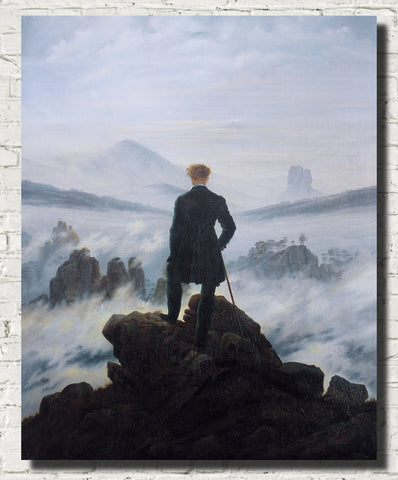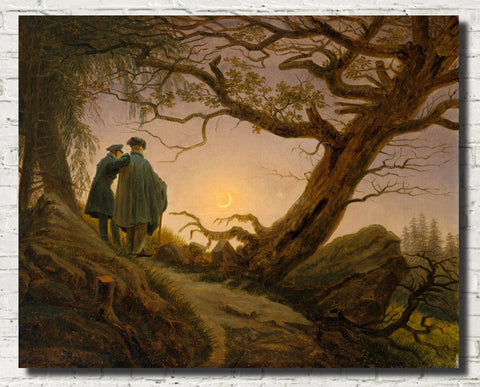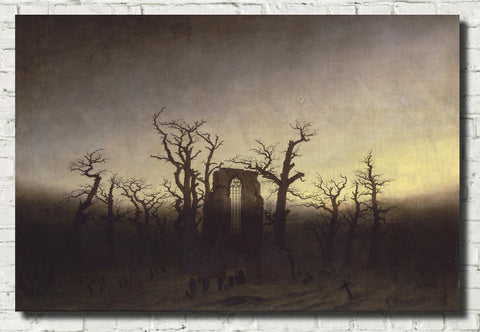Caspar David Friedrich - Sublime Landscapes
Table of Contents:[hide]
Caspar David Friedrich, a luminary of the German Romantic movement, left an indelible mark on the art world with his poignant depictions of nature. His paintings, characterized by contemplative figures set against vast landscapes, evoke a sense of the sublime – an awe-inspiring beauty that transcends the physical realm. In this blog post, we delve into the life, themes, and legacy of this influential artist.
Early Life and Influences
Caspar David Friedrich was born on September 5, 1774, in Greifswald, Swedish Pomerania, amidst a backdrop of Lutheran tradition and natural beauty. Raised in a family touched by tragedy, Friedrich's early encounters with death and the sublime majesty of nature would profoundly shape his artistic vision.
Journey into Artistry
Friedrich's artistic journey began with formal studies in Copenhagen, where he was introduced to the transformative power of nature by his mentor, Johann Gottfried Quistorp. Influenced by the Romantic ideals sweeping across Europe, Friedrich sought to convey the spiritual essence of the natural world through his works.
The Dresden Years
Settling in Dresden in 1798, Friedrich found inspiration in the rugged landscapes of northern Germany. His paintings, often executed in ink, watercolor, and sepia, captured the ethereal beauty of the Baltic coast and the Harz Mountains. Through meticulous observation and introspection, Friedrich elevated landscape painting to new heights, imbuing it with profound emotional resonance.
Themes of Contemplation and Solitude
At the heart of Friedrich's oeuvre lies a fascination with solitude and the human connection to the sublime. His iconic "Wanderer above the Sea of Fog" epitomizes this theme, portraying a lone figure gazing out over a misty landscape, emblematic of mankind's quest for meaning in the vastness of existence.
Symbolism and Allegory
Throughout his career, Friedrich employed symbolism and allegory to convey deeper philosophical truths. From the stark beauty of winter landscapes to the somber imagery of death and redemption, his paintings resonate with timeless themes of mortality and transcendence.
Legacy and Influence
Despite facing obscurity in his later years, Friedrich's legacy endured, influencing generations of artists from the Expressionists to the Surrealists. His visionary approach to landscape painting continues to captivate audiences worldwide, inviting viewers to embark on a journey of introspection and awe.
Conclusion
Caspar David Friedrich's artistic legacy transcends mere representation, offering a profound meditation on the human condition and our relationship to the natural world. Through his masterful compositions and evocative imagery, Friedrich invites us to contemplate the sublime mysteries of existence, echoing across the ages.
Caspar David Friedrich Prints and Canvas Panels
Prints and ready to hang canvas panels of Caspar David Friedrich's paintings are available in a range of sizes with fast worldwide delivery.
Caspar David Friedrich FAQ's
-
Who was Caspar David Friedrich?
- Caspar David Friedrich was a prominent German Romantic landscape painter born on September 5, 1774, known for his evocative portrayals of nature and contemplative figures.
-
What are some key themes in Friedrich's artwork?
- Friedrich's paintings often explore themes of solitude, contemplation, the sublime beauty of nature, and the transient nature of human existence.
-
What is the significance of Friedrich's use of symbolism?
- Symbolism played a crucial role in Friedrich's art, with elements such as ruins, crosses, and solitary figures imbued with deeper philosophical and allegorical meanings, inviting viewers to ponder life's mysteries.
-
What influenced Friedrich's artistic style?
- Friedrich's style was influenced by Romantic ideals, including a reverence for nature, a fascination with the sublime, and a rejection of the rationalism of the Enlightenment era.
-
What are some of Friedrich's most famous paintings?
- Iconic works by Friedrich include "Wanderer above the Sea of Fog," "The Abbey in the Oakwood," "The Sea of Ice," and "Chalk Cliffs on Rügen," each renowned for their emotional depth and visual power.
-
How did Friedrich's personal life influence his art?
- Friedrich's early experiences of loss and solitude, including the death of family members and his own struggles with depression, deeply influenced the melancholic and introspective quality of his paintings.
-
Was Friedrich's art appreciated during his lifetime?
- While Friedrich enjoyed some success early in his career, his later years were marked by obscurity and financial struggles. It was only in the 20th century that his work experienced a resurgence in popularity.
-
What is Friedrich's legacy in the art world?
- Friedrich's legacy looms large in the history of art, with his innovative approach to landscape painting inspiring generations of artists. He is celebrated for his ability to evoke profound emotional and spiritual responses through his art.
-
How did Friedrich's paintings reflect Romantic ideals?
- Friedrich's emphasis on individual emotion, the power of nature, and the sublime echoes the broader Romantic movement's rejection of rationalism and embrace of subjective experience.























